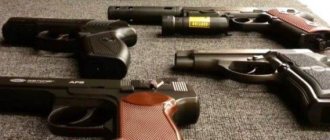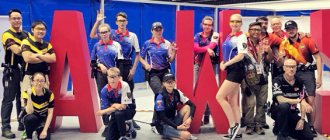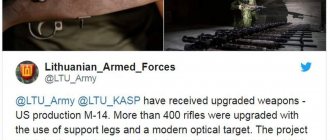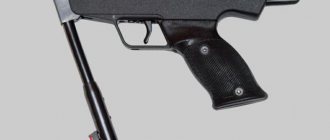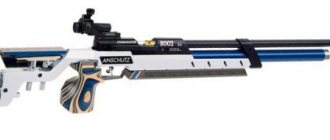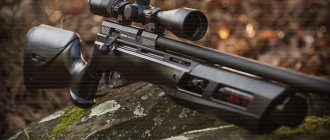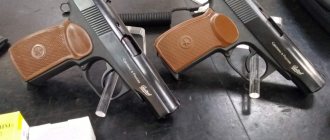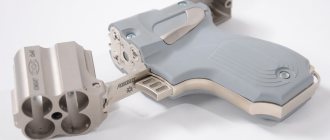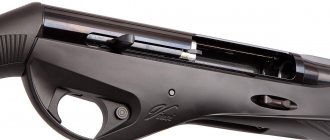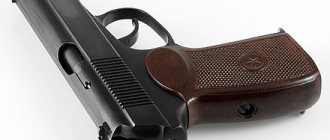PISTOLS “ASTRA” 80\90\100 (SPAIN)
PISTOLS “ASTRA” 80\90\100 (SPAIN)
The Astra A-80, A-90 and A-100 pistols were developed by the Spanish company Astra-Unceta y Cia SA in 1982, 1985 and 1990, respectively. The A-90 and A-100 pistols are direct descendants of the A-80 pistol, differing from it mainly in the design of safety devices and minor changes in appearance.
The Astra A-80 pistol largely replicates the famous SIG-Sauer P-220 pistol. The A-80 is also built according to a scheme with a short barrel stroke and locking the barrel with one lug behind the window for extracting cartridges in the bolt. The barrel is lowered to disengage from the bolt by interacting a shaped cutout in the boss under the barrel with elements of the pistol frame. The double-action trigger mechanism has an automatic safety lock that blocks the movement of the striker until the trigger is pressed. In addition, on the left side of the frame there is a lever for safely decocking the hammer. There are no conventional non-automatic fuses. Unlike the R-220, the A-80 has staggered magazines with a larger capacity.
The A-90 pistol differs from the A-80 only in enhanced safety measures - in addition to the already mentioned safety release lever and firing pin lock, a manual safety was added, located on the bolt and having a double-sided lever. When turned on, the safety moves the rear part of the firing pin out of the way of the trigger (the firing pin consists of two parts - the front is blocked by an automatic safety, the rear is not connected to a non-automatic manual safety). This design provides fairly high reliability, but is quite complex in design.
The A-100 pistol is largely a throwback to the original A-80 model - there is no manual safety, but only a safety release lever and a firing pin lock.
All Astra A-80/90/100 series pistols are high-quality and reliable weapons.
TTX:
Trigger: double action Caliber: A-80 - 9×19 Luger/Parabellum; 9x23mm Largo; .38 Super; .45ACP A-90 - 9×19 mm Luger/Parabellum or .45ACP A-100 - 9×19 mm Luger/Parabellum, .40SW or .45ACP Weight without cartridges: A-80, 90, 100 - 985 g Length: 180 mm Barrel length: 95 mm Magazine capacity: A-80 - 15 rounds (9 mm) A-90 - 17 rounds (9 mm) or 9 rounds (.45) A-100 - 15 rounds (9 mm), 13 rounds ( .40) or 9 rounds (.45)
Source: planetgun.ru
Chassis and brakes
The German's suspension is a bit harsh, with independent MacPherson struts used at the front and a semi-independent beam at the rear.
Most chassis elements last 100 thousand kilometers, not counting bushings and stabilizer struts. The structures are still the same even on the worst roads, at most you will change the shock absorbers sooner. Suspension parts cost pennies. The brake system at the front is always ventilated disc with ABS, and at the rear it depends on the configuration - drums or discs. The 1.6-liter Astra engines have weak discs, which are frankly not enough; they can only be replaced with others by replacing the hubs and brackets.
ABS needs to be monitored, in addition to the natural rot of tubes and wiring, it can simply turn off, give out casings, etc. When inspecting, check the vacuum booster to make sure it is not leaking.
The steering rack often knocks, and leaks are rare for it. The part is cheap and can even be replaced. The backlash is not caused by the rack, but by the cardan and the joint between the rack and the steering wheel.
A-50U: advanced flying radar
The basis for the new AWACS complex was one of the most reliable transport aircraft - the Il-76. This aircraft is easily distinguished from the usual Il-76 by the characteristic “mushroom” on the pylons above the upper part of the fuselage.
The characteristics of the A-50 are impressive even today: the detection range of air targets can reach 650 km, and the number of escorts can reach up to 300. The aircraft is capable of staying in the air for up to four hours, and refueling almost doubles this figure.
In 2011, Russian military aviation received another A-50 aircraft, but with the letter “U”. Specialists from the Vega Concern, part of the Ruselectronics holding, took part in the modernization of the aircraft.
Compared to its predecessor, the A-50U can track a larger number of targets, has an increased detection range of various types of aircraft, and can operate completely autonomously. That is, commands can come on board the fighter automatically, rather than being broadcast. Workplaces for crew members were modernized. For example, all information is displayed on displays and liquid crystal indicators; a buffet with household equipment and rest rooms for the crew have also appeared on board.
In March of this year, Concern Vega and TANTK named after. G.M. Beriev transferred the sixth A-50U aircraft into operation for the Russian Aerospace Forces. In parallel with the modernization of the A-50, work is underway to create a new AWACS aviation complex. We can say that the A-50U is a transitional version to the new A-100 Premier aircraft.
The first “mushroom” over the fuselage
The aviation radio detection and guidance complex is often called the “flying headquarters”. The electronic reconnaissance and control system installed on the aircraft is designed for long-range detection of enemy targets, targeting or intercepting weapons at them, as well as issuing information to command posts.
The first project of domestic long-range radar detection aviation was the Tu-126 aircraft with the Liana radio-technical complex installed on it. This complex was put into service in 1965. In those years, long-range radar detection of air targets from an aircraft became an excellent way to strengthen the country’s northern borders. The deployment of ground-based air defense systems in the Far North required not only large material costs, but also time. A solution was found in the creation of mobile systems that were mounted on aircraft. The aviation long-range radar detection system (AWACS) was also distinguished by its ease of use, for example, the ability to quickly fly to other directions, and a significantly greater target detection range.
The Liana system on the Tu-126 made it possible to detect air targets at ranges from 100 to 350 km, and sea targets - up to 400 km. At the same time, the on-board equipment could transmit the received information to air defense and naval command posts at a distance of 2 thousand km from the aircraft. The Liana antenna was mounted on a pylon above the fuselage, and it was the first domestic aircraft with a rotating mushroom-shaped radar.
At the end of the 20th century, a new tactic for overcoming air defense radar zones appeared - aircraft flying at low altitude produce such a small signal compared to reflections from the earth's surface that they become difficult to detect. New AWACS aircraft with the ability to detect low-flying targets have become necessary. So in 1978, the A-50 long-range radar detection and control aviation complex appeared.
Body
Opel has always been famous as a car that rusts quickly, but each time General Motors corrected the situation. The previous generation G is worse in terms of durability than the future, and this is always the case, but it is far from ideal.
It is worth inspecting the car thoroughly, most often the source of corrosion is the place of the thresholds, closed by doors and sometimes the edge of the doors. On a hatchback, the problem is the rear chrome trim; it rubs against the lid, erasing the paintwork and leading to rust. Otherwise, corrosion is minimal due to full galvanization. Most Russian cars are produced here; diesel engines are imported from Europe. Check this nuance, because Polish cars suffer from frequent paint swelling.
Among the body problems of the Opel Astra N in the first years of production, the headlights quickly become cloudy and the door handles jam. After purchase, in order to get rid of the spread of internal corrosion of the thresholds, you need to drain the water from under the rubber seals.
There is no point in discussing the design, firstly, it is simple, and secondly, everyone has seen the car in this body. The company produced as many as 5 body versions - sedan, 5-door hatchback, 3-door GTC hatchback, station wagon and convertible. All types of bodies are found on the secondary market.
Sedan dimensions:
- length – 4587 mm;
- width – 1753 mm;
- height – 1458 mm;
- wheelbase – 2703 mm.
Dimensions of the 5-door hatchback:
- length – 4249 mm;
- width – 1753 mm;
- height – 1460 mm;
- wheelbase – 2614 mm.
Dimensions of Astra GTC:
- length – 4290 mm;
- width – 1804 mm;
- height – 1435 mm;
- wheelbase – 2614 mm.
Station wagon dimensions:
- length – 4515 mm;
- width – 1804 mm;
- height – 1500 mm;
- wheelbase – 2703 mm.
Dimensions of the convertible:
- length – 4476 mm;
- width – 1831 mm;
- height – 1411 mm;
- wheelbase – 2614 mm.
In all cases, the ground clearance is 160 mm.
"Premier" radar surveillance and guidance
The new A-100 Premier aviation complex for radar surveillance and guidance received a fully digital navigation complex and a digital control system with a “glass” cockpit, as well as an active phased array produced by the Vega Concern.
The base for the complex was the Il-76MD-90A aircraft with new low-noise and more powerful PS-90A-76 engines. In total, about 20 tons of unique radio-electronic equipment are installed on this Il. It allows the A-100 to instantly detect, identify and classify targets, instantly transmit information to control points for target designation of ship-based and ground-based anti-aircraft weapons.
As Vladimir Verba, general designer of the Vega Concern, corresponding member of the Russian Academy of Sciences, noted, the results of the most advanced research in the field of radar and information technology have been implemented in the new generation of flying radars. “For the A-100, technical solutions were used based on a modern electronic component base, high-performance computing tools, and the latest achievements of domestic radio electronics. This applies to both the means of obtaining information and the computing complex for processing it, as well as automated operator workstations,” he commented.
Despite the fact that the technical characteristics of the A-100 still remain classified information, experts, taking into account the capabilities of the A-50U and the complete update of the board, believe that the level of the newest Russian complex significantly exceeds both domestic and foreign analogues.
